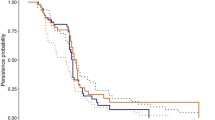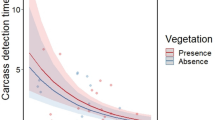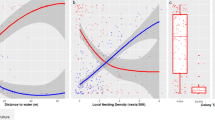Abstract
We identified vertebrate scavengers of small mammal carcasses at the 780-km2 Savannah River Site during the winter of 2000–2001. Rodent carcasses, differing in size and visual conspicuousness, were placed in upland pine forests and bottomland hardwood forests during six 2-week periods. Sixty-two of the 96 carcasses (65%) were removed by vertebrates. With the aid of remote photography, we identified 11 species of scavengers removing carcasses. RaccoonsProcyon lotor, gray foxesUrocyon cinereoargenteus, and feral pigsSus scrofa scavenged most frequently. The mean elapsed time for carcass removal was 5.6 days. The number of carcasses removed by vertebrates did not differ significantly with respect to carcass size, visual conspicuousness, or habitat type; however, air temperature was strongly correlated (positively) with carcass removal. Our study demonstrates that many mammal species are capable of utilizing small carrion items as a food resource, and suggests that scavenging may account for a higher proportion of the diet of some facultative scavengers than is now widely assumed.
Similar content being viewed by others
References
Balcomb R. 1986. Songbird carcasses disappear rapidly from agricultural fields. Auk 103: 817–820.
Bobek B. 1969. Survival, turnover and production of small rodents in a beech forest. Acta Theriologica 14: 191–210.
Bobek B. 1973. Net production of small rodents in a deciduous forest. Acta Theriologica 18: 403–434.
Cooper S. M., Holekamp K. E. and Smale L. 1999. A seasonal feast: long-term analysis of feeding behaviour in the spotted hyaena (Crocuta crocuta). African Journal of Ecology 37: 149–160.
Cowles R. B. and Phelan R. L. 1958. Olfaction in rattlesnakes. Copeia 1958: 77–83.
Halley D. J. and Gjershaug J. O. 1998. Inter- and intra-specific dominance relationships and feeding behaviour of Golden EaglesAquila chrysaetos and Sea EaglesHaliaeetus albicilla at carcasses. Ibis 140: 295–301.
Henry J. D. 1977. The use of urine marking in the scavenging behavior of the red fox (Vulpes vulpes). Behaviour 61: 82–105.
Hooge P. N. and Eichenlaub B. 1997. Animal movement extension to ArcView. Ver. 1.1. Alaska Biological Science Center, U.S. Geological Survey, Anchorage, Alaska.
Hosmer D. W. and Lemeshow S. 1989. Applied logistic regression. Wiley and Sons, New York: 1–307.
Houston D. C. 1979. The adaptations of scavengers. [In: Serengeti, dynamics of an ecosystem. A. R. E. Sinclair and M. N. Griffiths, eds]. University of Chicago Press, Chicago: 263–286.
Janzen D. H. 1977. Why fruits rot, seeds mold, and meat spoils. The American Naturalist 111: 691–713.
Jones M. E. 1998. The function of vigilance in sympatric marsupial carnivores: the eastern quoll and the Tasmanian devil. Animal Behaviour 56: 1279–1284.
McKillup S. C. and McKillup R. V. 1994. The decision to feed by a scavenger in relation to the risks of predation and starvation. Oecologia 97: 41–48.
Mullen D. A. and Pitelka F. A. 1972. Efficiency of winter scavengers in the Arctic. Arctic 25: 225–231.
Norusis M. J. 1999. SPSS regression models 10.0. SPSS, Inc., Chicago: 1–82.
Pain D. J. 1991. Why are lead-poisoned waterfowl rarely seen?: the disappearance of waterfowl carcasses in the Camargue, France. Wildfowl 42: 118–122.
Payne J. A. 1965. A summer carrion study of the baby pigSus scrofa Linnaeus. Ecology 46: 592–602.
Putman R. J. 1976. Energetics of the decomposition of animal carrion. PhD thesis, University of Oxford, Oxford: 1–131.
Putman R. J. 1978. Patterns of carbon dioxide evolution from decaying carrion. Decomposition of small mammal carrion in temperate systems 1. Oikos 31: 47–57.
Putman R. J. 1983. Carrion and dung: the decomposition of animal wastes. Edward Arnold, London: 1–62.
Rosene W. and Lay D. W. 1963. Disappearance and visibility of quail remains. The Journal of Wildlife Management 27: 139–142.
Shean B. S., Messinger L. and Papworth M. 1993. Observations of differential decomposition on sun exposed v. shaded pig carrion in coastal Washington State. Journal of Forensic Sciences 38: 938–949.
Shivik J. A. 1999. Carrion, context, and lure development: the relative importance of sensory modalities to foraging brown treesnakes (Bioga irregularis). PhD thesis, Colorado State University, Fort Collins: 1–121.
Shivik J. A. and Clark L. 1997. Carrion seeking in brown tree snakes: importance of olfactory and visual cues. Journal of Experimental Zoology 279: 549–553.
Simonetti J. A., Yanez J. L. and Fuentes E. R. 1984. Efficiency of rodent scavengers in central Chile. Mammalia 48: 608–609.
SPSS. 1999. SPSS base 10.0 applications guide. SPSS, Inc., Chicago: 1–426.
Tobin M. E. and Dolbeer R. A. 1990. Disappearance and recoverability of songbird carcasses in fruit orchards. Journal of Field Ornithology 61: 237–242.
Wallace M. P. and Temple S. A. 1987. Competitive interactions within and between species in a guild of avian scavengers. Auk 104: 290–295.
White D. L. and Gaines K. F. 2000. The Savannah River Site: site description, land use, and management history. Studies in Avian Biology 21: 8–17.
Wiggins-Brown H., Pinder J. E. III, Guy K. K. and Rea T. E. 2000. 1999 Habitat map of the Savannah River Site. Savannah River Ecology Laboratory, Aiken, South Carolina.
Wilton M. L. 1986. Scavenging and its possible effects upon predation — a selective review of literature. Alces 22: 155–180.
Workman S. K. and McLeod K. W. 1990. Vegetation of the Savannah River Site: major community types. SRO-NERP-19. Savannah River Ecology Laboratory, South Carolina: 1–137.
Author information
Authors and Affiliations
Rights and permissions
About this article
Cite this article
DeVault, T.L., Rhodes, O.E. Identification of vertebrate scavengers of small mammal carcasses in a forested landscape. Acta Theriol 47, 185–192 (2002). https://doi.org/10.1007/BF03192458
Received:
Accepted:
Issue Date:
DOI: https://doi.org/10.1007/BF03192458




